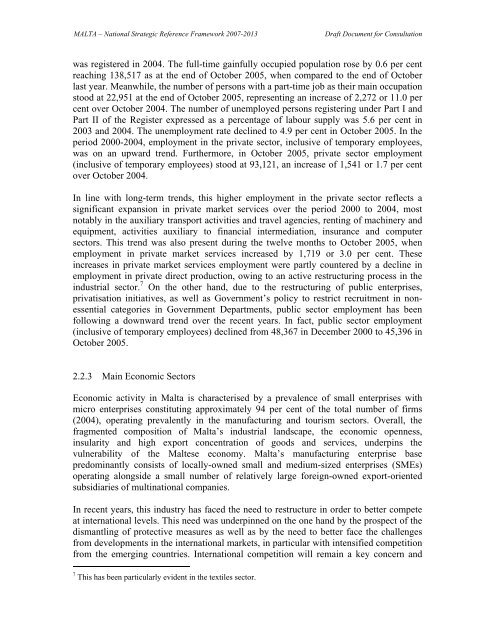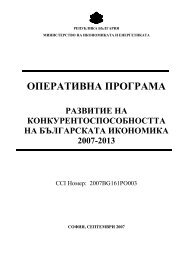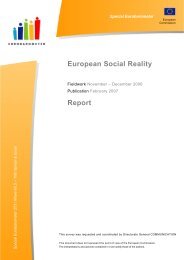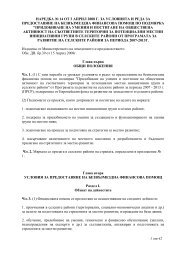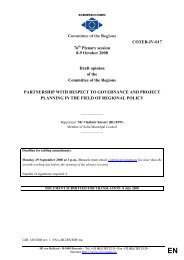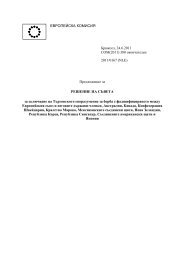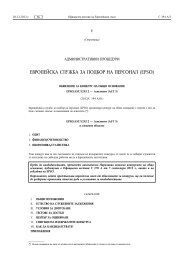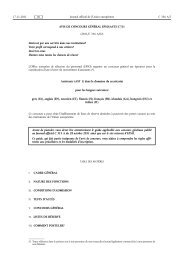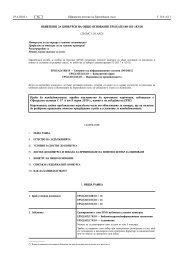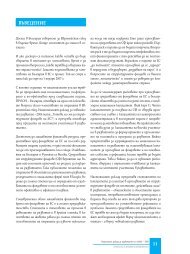National Strategic Reference Framework
National Strategic Reference Framework
National Strategic Reference Framework
You also want an ePaper? Increase the reach of your titles
YUMPU automatically turns print PDFs into web optimized ePapers that Google loves.
MALTA – <strong>National</strong> <strong>Strategic</strong> <strong>Reference</strong> <strong>Framework</strong> 2007-2013 Draft Document for Consultation<br />
was registered in 2004. The full-time gainfully occupied population rose by 0.6 per cent<br />
reaching 138,517 as at the end of October 2005, when compared to the end of October<br />
last year. Meanwhile, the number of persons with a part-time job as their main occupation<br />
stood at 22,951 at the end of October 2005, representing an increase of 2,272 or 11.0 per<br />
cent over October 2004. The number of unemployed persons registering under Part I and<br />
Part II of the Register expressed as a percentage of labour supply was 5.6 per cent in<br />
2003 and 2004. The unemployment rate declined to 4.9 per cent in October 2005. In the<br />
period 2000-2004, employment in the private sector, inclusive of temporary employees,<br />
was on an upward trend. Furthermore, in October 2005, private sector employment<br />
(inclusive of temporary employees) stood at 93,121, an increase of 1,541 or 1.7 per cent<br />
over October 2004.<br />
In line with long-term trends, this higher employment in the private sector reflects a<br />
significant expansion in private market services over the period 2000 to 2004, most<br />
notably in the auxiliary transport activities and travel agencies, renting of machinery and<br />
equipment, activities auxiliary to financial intermediation, insurance and computer<br />
sectors. This trend was also present during the twelve months to October 2005, when<br />
employment in private market services increased by 1,719 or 3.0 per cent. These<br />
increases in private market services employment were partly countered by a decline in<br />
employment in private direct production, owing to an active restructuring process in the<br />
industrial sector. 7 On the other hand, due to the restructuring of public enterprises,<br />
privatisation initiatives, as well as Government’s policy to restrict recruitment in nonessential<br />
categories in Government Departments, public sector employment has been<br />
following a downward trend over the recent years. In fact, public sector employment<br />
(inclusive of temporary employees) declined from 48,367 in December 2000 to 45,396 in<br />
October 2005.<br />
2.2.3 Main Economic Sectors<br />
Economic activity in Malta is characterised by a prevalence of small enterprises with<br />
micro enterprises constituting approximately 94 per cent of the total number of firms<br />
(2004), operating prevalently in the manufacturing and tourism sectors. Overall, the<br />
fragmented composition of Malta’s industrial landscape, the economic openness,<br />
insularity and high export concentration of goods and services, underpins the<br />
vulnerability of the Maltese economy. Malta’s manufacturing enterprise base<br />
predominantly consists of locally-owned small and medium-sized enterprises (SMEs)<br />
operating alongside a small number of relatively large foreign-owned export-oriented<br />
subsidiaries of multinational companies.<br />
In recent years, this industry has faced the need to restructure in order to better compete<br />
at international levels. This need was underpinned on the one hand by the prospect of the<br />
dismantling of protective measures as well as by the need to better face the challenges<br />
from developments in the international markets, in particular with intensified competition<br />
from the emerging countries. International competition will remain a key concern and<br />
7 This has been particularly evident in the textiles sector.


